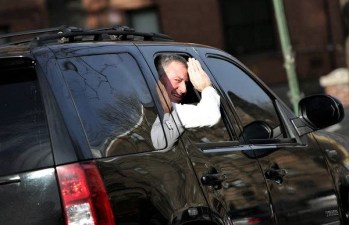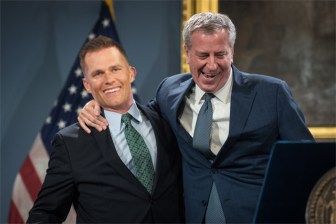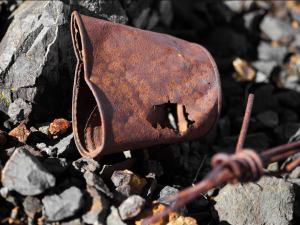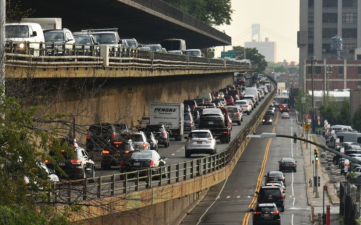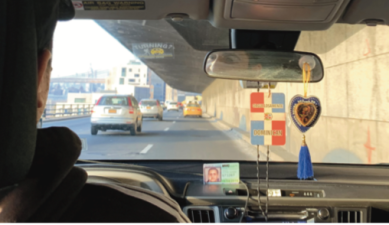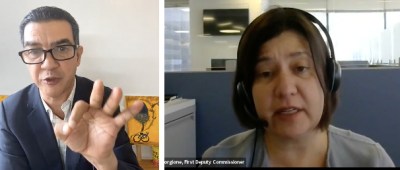ANALYSIS: The Mayor’s ‘Bold’ Plan for the BQE is Not Bold, But is Really a Long Punt
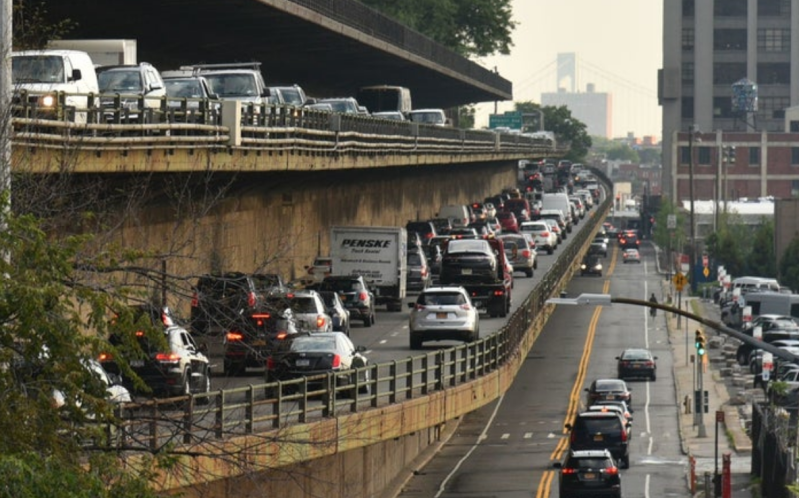
Mayor de Blasio called his patch-and-plan strategy for shoring up the Brooklyn-Queens Expressway “bold” on Wednesday, but admitted that he has punted a full re-imagination of the outdated, racially unjust, life-choking Robert Moses-era highway to the next mayor, or, really, the mayor after that.
De Blasio and Department of Transportation Commissioner Hank Gutman announced three specific measures to preserve the highway’s beleaguered 1.3-mile section between Atlantic Avenue and Sands Street: basic maintenance, better monitoring, and increased truck weight enforcement. That approach, the mayor said, will “buy time” for the fourth piece of the mayor’s “plan” for the entire expressway between Queens and the Verrazzano Narrows Bridge: allowing the next mayor to devise the long-term plan (in other words, that part of the plan isn’t actually in the plan).
The lackluster announcement follows a series of missteps by the de Blasio administration. In September, 2018, the DOT said the .4-mile triple cantilevered-stretch under tony Brooklyn Heights (where Gutman lives) would collapse by 2026 under the weight of the thousands of trucks that traverse it daily if it was not fixed. The DOT then released two proposals for the entire dilapidated section between Atlantic Avenue and Sands Street, including the triple cantilever, but both were dismissed as unpalatable to Brooklyn Heights and Cobble Hill residents. In the months following, a slew of other ideas were put forward — the two boldest of which were from the Regional Plan Association, which proposed nixing two lanes of traffic; and from Comptroller Scott Stringer, who called for banning all cars on the expressway, making it truck-only, and covering some portions with green space.
Instead, the de Blasio administration created a so-called expert panel that was tasked with coming up with a new design to ensure, as the mayor said at the time, “we get this right.”
So did he? He certainly thinks so:
“There were imperfect realities in the solutions offered, and it caused people to go back to the drawing board, which is often a very healthy thing to do,” de Blasio said on Wednesday about the earlier missteps. “That led to recognition that maybe we could approach the core, immediate problem [the imminent collapse] very differently and buy a lot more time, the right way. So, I think what’s been achieved here is a change of the terms of engagement. We’re now talking about having the time to do the really big, creative stuff.”
Big? Creative? You be the judge:
Preserving the structure
The substantive part of the de Blasio administration’s plan calls for reducing the roadway from three lanes of traffic in each direction to two — not on the full cantilever, but along just half a mile from about Atlantic Avenue to the Brooklyn Bridge. The shift will start later this month, the mayor said.
Not only is this not new — it was suggested more than two years ago by both the expert panel and the Regional Plan Association — but it’s still only a fraction of what was proposed at the time, which was to nix a lane in each direction along the entire 1.3-mile cantilevered stretch, facilitating a reduction in traffic volumes by 15 percent, from the current 153,000 vehicles to about 125,000.
Looks like the BQE will be illuminated with gaslight: @NYCMayor’s “bold” plan for the highway includes only one change: repainting lanes from three to two. Beyond that, city will enforce weight rules, waterproof the structure, “develop a vision” for the future…and pray. pic.twitter.com/vpaoE78nMb
— Streetsblog New York (@StreetsblogNYC) August 4, 2021
The change announced on Wednesday, Gutman said, will only reduce traffic volume by 10 percent.
“But it will reduce the load on the structure, which is one of the ways we get the extra life and safety out of it,” he said.
De Blasio had even initially scoffed at that idea, buying into the false narrative that creating more space for cars reduces traffic — a theory dispelled by the proven phenomenon known as induced demand.
“We have to be careful [if] we reduce, the amount of lanes,” de Blasio said at the time. “The problem I have with that is one, that’s not a guarantee that people get out of the cars. It is a guarantee of traffic jams and it is a guarantee of other challenges.”
Other aspects of the plan to keep the triple cantilever from collapsing include “weigh-in-motion” technology to automatically issue a summons to overweight trucks; additional NYPD enforcement stings once per month; slowing down corrosion from water infiltration (i.e. doing proper maintenance); and finishing repairs to the crumbling retaining wall along Hicks Street — most of which were already announced, and in-the-works years ago. But without addressing the root of the problem — the 153,000 cars and 14,000 trucks that traverse the BQE daily — it’s unclear how these minimal changes will all of a sudden prevent its demise.
Shifting freight
Another part of the de Blasio plan calls on the city to save the BQE by making greater use of waterways and rail to move freight into and within the city — but he also admitted such a revolutionary change would have to be taken up by his successors.
“Getting more and more of our freight in general off the roads, onto rail, onto the water…and turning to smaller vehicles … electric vehicles, even in some cases, human-powered delivery … cargo bikes. All of these things need to happen,” said de Blasio, who has been mayor since Jan. 1, 2014. “The Economic Development Corporation has already been working on some of these alternative ways of moving freight around, rail, water, etc. … The next administration can take it from there.”
Most of the work of reimagining freight is being done by corporations such as UPS, DHL and Amazon/Whole Foods, via its bike delivery caravans that launched in 2019. Meanwhile, the city is moving at its own snail’s pace to keep up. Commercial trucks still deliver roughly 90 percent of our goods — just 8 percent are floated here via the city’s waterways and a mere 3 percent arrive by rail. Very little cargo travels around on cargo bikes for several reasons, including state law which still restricts the width of payloads and the danger that delivery workers face on streets that are far more tailored to the needs of truck drivers than bike riders.
A 104-page report, “Delivering New York: A Smart Truck Management Plan for New York City,” released in May, and referenced again Wednesday in relation to the BQE announcement, outlined much of the problem with the very system the mayor said must change, but fell short of solutions.
That report followed FreightNYC, another trucking scheme launched in 2018 by the city’s Economic Development Corporation, which sought to “modernize the city’s freight distribution system through strategic investments in maritime and rail infrastructure, as well as the creation of new distribution facilities.” But at its best, those initiatives still only predicted relatively small gains: a $25-million “hub and spoke” marine freight system and a $15-million rail transfer center that would reduce truck modal share by about 5 percent, bringing it down to 85 percent. The three-year-old FreightNYC report was also referenced on Wednesday.
Asked more about the city’s concrete plans to rely less on the trucking industry and more on water and rail, de Blasio told Streetsblog back in May that “there’s a lot of work to be done.” In the months since, it doesn’t seem like any more has.
Engaging the community
Despite de Blasio’s pledge to “get this right” more than two years ago, Wednesday was the first time the city has addressed the need to look at the ways the entire highway has negatively impacted all of the neighborhoods through which it cuts, and even consider something as bold as knocking down the BQE in its entirety, and turning in into a boulevard-style roadway — a precedent set in other cities around the world, including Seattle, South Korea, and even in our very own Manhattan, with the West Side Highway a generation ago. But again, that hard work will be left to the next mayors.
De Blasio said that starting this summer and fall, the city will “engage affected communities from Staten Island to Queens, including businesses and the freight industry, on a corridor-wide vision for the long-term future of the BQE.”
To be clear, the city has been engaging with the community on the BQE since 2018 — but just the immediate neighborhoods of Brooklyn Heights and Cobble Hill. For the elected officials whose communities were left out of those discussions for years, the mayor’s announcement for a comprehensive reimagining — though still years away — was a welcome one.
“The process of redesigning the BQE must start now with a focus on those communities who have been most harmed by decades of environmental racism,” said Williamsburg Council Member Antonio Reynoso, and presumptive Brooklyn Borough President-elect.
Robert Moses destroyed communities across 2 boroughs when he built the BQE. It’s time to right those wrongs.
The process of redesigning the BQE must start now with a focus on those communities who have been most harmed by decades of environmental racism.
— Antonio Reynoso (@CMReynoso34) August 4, 2021
The head of the Brooklyn Heights Association — the powerful civic group that made its bones when it got Moses to re-route the highway under instead of through the wealthy neighborhood decades ago — said the mayor’s radical realization and announcement is a good start, albeit long overdue.
“I don’t think we are back where we were in 2018, the DOT was saying that it wanted to fix the cantilever as is and essentially rebuild it,” said BHA’s Executive Director Lara Birnback. “We’ve come a long way since that time. It’s frustrating that when the mayor’s expert panel released its recommendations, I wish the mayor at that point had embraced them and started to put in place what we are now talking about 18 months later. We want a discussion about how we rely less on private vehicles and reduce trucks, and whether we need a highway at all. I’m hopeful we will finally start having those conversations up and down the entire corridor across all neighborhoods that are negatively impacted by the BQE.”
The underwhelmed reaction
Given what reporters heard on Wednesday, and how many times the mayor and his cheerleaders used the term “bold,” it’s no wonder most saw the shoring up proposal as anything but.
“Any comprehensive plan to rebuild the 71-year-old highway would be the responsibility of his successor,” the Daily News pointed out. Reporters’ questions at the press conference were also incredulous:
“If that solution-finding had started four or five years ago, we might be able to have a long-term vision now instead of a sort of this 20-year fix that necessitates another solution down the road,” said Steve Burns from WCBS radio. “So, I understand the rationale here for the short-term fix, but why couldn’t we go longer term sooner than we are right now?”
A question from Kevin Duggan of amNY also revealed that the reporter was unimpressed.
“A lot of people have been calling for more, you know, dramatic transformation with the BQE,” he said. “Some call to tear it down entirely or try some sort of park. Do you think they might be disappointed that this plan basically kicks the future of it down the road almost 20 years possibly?”
Others expressed their surprise on Twitter:
The city’s plan for the deteriorating BQE cantilever is to KEEP IT THERE, “take preservation steps” & restrict truck traffic to buy the structure another 20 years.
— David J. Meyer (@dahvnyc) August 4, 2021
And one livable streets advocate said it just feels like the city’s way of again putting off dealing with any big, structural changes, telling Streetsblog that the plan is anything but “bold.”
Still, RPA cheered the announcement, arguing that the lane reduction is a small, but important incremental step to a more substantial change — some day.
“It just represents a seismic shift in the mayor’s and DOT’s thinking. It’s just half a mile, but to me it looks like a paradigm shift. This is a highway lane reduction, to me it’s radical,” said the RPA’s Rachel Weinberger.
Weinberger excused the mayor’s johnny-come-lately approach towards the BQE and its blight on the city, claiming that neither the city’s engineers, the expert panel, or even the RPA had been looking at it from a larger perspective — despite advocates doing just that.
“What we are seeing is an evolution in thinking,” she said.
But McClure, of StreetsPAC, refused to gush.
“We were all told it would start falling apart by 2026 and now there’s some intermediate miracle cure to make it usable for another 20 years?” he said. “It just seems like not a very forward thinking solution to the whole issue.”
Danny Harris, the executive director of Transportation Alternatives, said he was “encouraged by the new road diet, commitment to shift freight, and plans for corridor-wide community engagement,” but the text of his statement suggested a larger disappointment.
“We will continue to push for repealing the car-centric and racist legacy of Robert Moses,” he added. “We need to wholly reimagine all of our urban highways – including the BQE – and create space for people that is safe, equitable, sustainable, and helps to break car culture. The next mayor must make this central to their plan for NYC 25×25 and ensure we are building for our people-focused future and not our traffic-focused past.”
